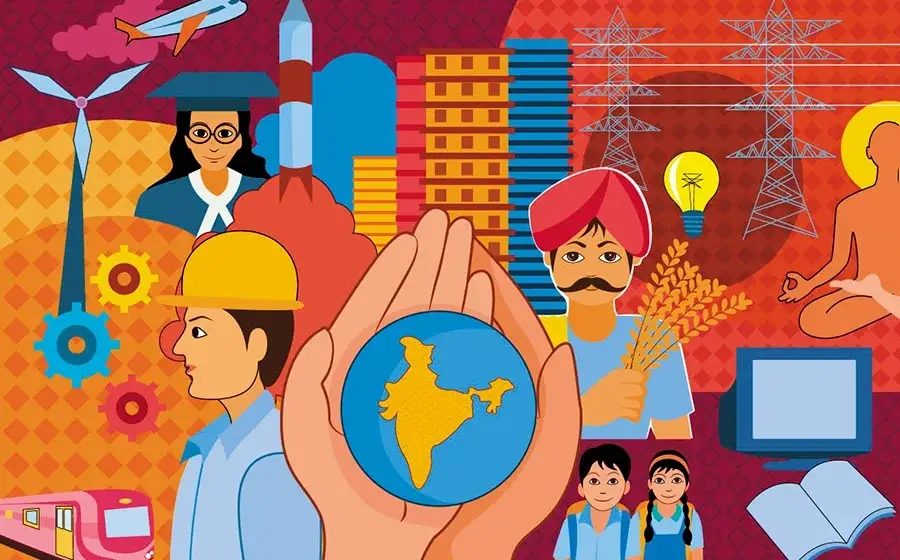Work opportunities for seekers & carving out more job-givers be the focus, emphasis on big picture will drive economic expansion
K.A.Badarinath / New Delhi
When finance minister Nirmala Sitharaman rises to present her fourth budget in continuum on February 1, the dedicated app, tablet or bahri katha will in all likelihood croon ‘naya bharat’ – New India — big time.
One should not miss this soft singing for the determined bid she will make by laying threadbare plans to build ‘New India’ of her leader Prime Minister Narendra Modi’s dreams.

As the country gets ready for next economic prosperity cycle, 75-years post-independence, this plan and vision to turn India into a global economic power house would definitely be significant.
Finance Minster Sitharaman who’s credited with steering the economy through the Covid 19 pandemic deftly cannot afford to ignore or set aside the challenges that besiege Indian economy in medium term.
Well, if third wave of corona virus infections is waning out as experts believe, this should signal a comprehensive plan to rebuild what was lost to the pandemic and nurture the dream of $ 5 trillion economic muscle that drives the global growth impulses.
GDP growth of 9.2 per cent projected for 2021-22, highest in 17-years should be the basis for rolling out the big picture while holding the handle firmly to sustain this growth momentum next five years in a row.
Crude prices hitting $ 100 from current $ 86 per barrel may be the first big challenge she needs to factor in her budget package. Fuel induced inflationary pressures is what could moderate her big plans. Let’s not forget that fuel inflation was 10.95 per cent in December, 2021, 13.35 per cent in November 2021 and 14.35 per cent.

With oil imports to cross $ 100 billion again next fiscal, reining in consumer centric inflation will still be a tricky preposition given that it touched 5.59 per cent in December 2021.
Pointing to inflationary pressures leading to interest rate hikes is not to distract the Finance Minister away from her top priority to put the economy on high growth trajectory.
We should be able to live with 4 – 6 per cent retail inflation next three years even as Nirmala Sitharaman goes about methodically in fiscal consolidation to putting economy on firm expansion mode.
Unlike US and Europe that are swept with 30 – 40 years high consumer inflation, India still has headroom in inflation management as well as moderating interest rates.
Growth, growth and more growth should be the only mantra that dictates Finance Minister’s budget package which got deviated last two years owing to Covid 19 management and related expenses.
A conscious call will have to be taken on front-ending capital and infrastructure investments with at least 10 per cent increase in budget expenditure that was pegged at Rs 34,83,236 crore for 2021-22.
Government will have to tango both domestic and foreign investors to sustain healthy growth momentum with expansion in industry, services as well as exports. Since farmers have delivered and continue to do so with about four per cent agriculture growth, emphasis should be on industrial expansion and double digit growth of services with focus on external markets.
In this big picture, keeping the fiscal deficit at six per cent may not be a breeze next fiscal but doable given that 6.8 per cent target set for 2021-22 is all set to be achieved.
Healthy growth in goods and services tax revenues is a big plus in deficit management. About Rs 1.29 lakh crore collection in December 2021 and Rs 1.31 lakh crore in the month before only hints at pent up consumer demand that’s driving sales and resultant revenue mop up.

Merchandise exports at about $ 400 billion in 2021-22 are again a possibility. During January 1 – 7, 2022 alone, exports grew by about 25 per cent to $ 7.63 billion. Even in December 2021, India clocked an export growth of 36.2 per cent to $ 23.8 billion in just three weeks.
This momentum needs to be sustained to touch a possible $ 500 billion in the entire next fiscal. Putting together a big package to boost India’s share in global merchandise exports is something that Finance Minister Nirmala Sitharaman can do.
Given the adage that taxes are not exported, boosting tax revenues through exports is not what should happen. Instead exports linked manufacturing will help increase the work opportunities that have been hard to come by. Setting up export-linked manufacturing infrastructure will drive growth in near future.
This brings us to oft discussed question of growth versus jobs. Without creating jobs for millions of aspiring youngsters or an environment for job-givers, the $ 5 trillion dream means nothing for 1.4 billion Indians that are on the move. Official data shows that 1.39 million net new jobs were created in November 2021 registering 37.9 per cent increase year on year basis.
Finance Minister Sitharaman will have to carve out opportunities for workers in informal sector where millions may have to get into manufacturing, services and export-linked merchandise production. This needs to get a little innovative, if her budget package has to be accepted and sustained.
(Author is Director & Chief Executive Officer at Centre for Integrated & Holistic Studies. Views expressed are author’s own.)


Tread with caution: taxes & resources 29 Jan 2022
[…] There have been suggestions to consider the work from home allowance provided by companies for inclusion under standard income tax deductions provisions owing to over two years pandemic. Similarly, professionals and workers have lost their pay big time and millions have been given the pink slips. Finance Minister Sithraman may have to find ways for providing them some relief as has been done in last budget. […]